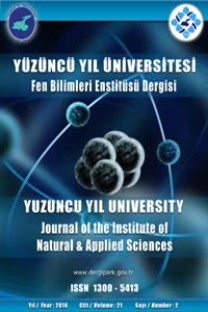Bakır Klorür İçeren Yeni Su Bazlı Membranın Dayanıklılığının Değerlendirilmesi
Bu çalışmada, toksik bir gaz olarak bilinen hidrojen sülfür (H2S) gazının gideriminde kullanılan yeni bir alternatif olan bakır klorür içeren su bazlı membranın dayanıklılığı araştırılmıştır. Membran hazırlanırken dökme yöntemi kullanılmıştır. Membran su bazlı reçine (%15 poliamid), alüminyum silikat, teknosol, CuCl2.2H2O, çözücü olarak distile su ve etil alkol içermektedir. Membranın 1M HCl, 1M NH3, %30 H2O2, 1M HNO3, 1M NaOH, gün ışığı ve saf suya karşı dayanıklılığı incelenmiştir. Bu etkenlerle 2 hafta muamele edilen membranın taramalı elektron mikroskobu (SEM), dijital mikroskop ile yüzey morfolojisindeki değişimler incelenmiştir. Membran yüzeyindeki gaz adsorplamasını teyit etmek amacıyla Enerji Dağılım Spektroskopisi (SEM-EDS) analizi yapılmıştır. Membranın yapı analizi ise X-ışını kırınım difraktometresi (XRD) analizi ile yapılmıştır. Çalışmalar sonucunda elde edilen veriler, değerlendirilerek membran morfolojisini etkileyen kimyasallar tespit edilmiştir. Çalışma, su bazlı membranın belli bir adsorpsiyon kapasitesinin olduğunu ve bu membranın çevreci bir alternatif olarak kullanılabileceğini ortaya koymuştur.
Anahtar Kelimeler:
Dayanıklılık, Ekolojik, Membran
Evaluation of the Durability of a New Water-Based Membrane Containing Copper Chloride
The durability of a new water-based membrane containing copper chloride, used to remove the toxic hydrogen sulfide (H2S) gas, was evaluated. The pouring method was used to fabricate the membrane. The membrane contained water-based resin (15% polyamide), aluminum silicate, technosol, CuCl2.2H2O, distilled water and ethyl alcohol as the solvent. The resistance of the membrane against 1 M HCl, 1 M NH3, 30% H2O2, 1 M HNO3, 1 M NaOH, sunlight, and pure water was investigated. The changes in the surface morphology of the membrane treated under these conditions for over two weeks were examined using a scanning electron microscope (SEM) and a digital microscope. The Energy Distribution Spectroscopy (SEM-EDS) analysis was performed to confirm the gas capture ability of the membrane surface. The structural analysis of the membrane was performed by the X-ray diffractometry (XRD) analysis. Based on the results, the chemicals affecting the membrane morphology were identified. The results also showed that the water-based membrane was characterized by a certain adsorption capacity, and this membrane might be used as an eco-friendly alternative to the currently used materials.
Keywords:
Durability, Ecological, Membrane,
___
- Bassindale, T., & Hosking, M. (2011). Deaths in Rotorua’s geothermal hot pools: Hydrogen sulphide poisoning. Forensic Science International, 207, 28-29. doi: 10.1016/j.forsciint.2010.11.025
- Chin, S. S., Chiang, K., & Fane, A. G. (2006). The stability of polymeric membranes in a TiO2 photocatalysis process. Journal of Membrane Science, 275, 202–211. doi: 10.1016/j.memsci.2005.09.033
- Costigan, M. G. (2003). Hydrogen sulfide: UK occupational exposure limits. Occupational and Environmental Medicine, 60, 308-312. doi: 10.1136/oem.60.4.308
- Elseviers, W. F., & Verelst, H. (1999). Transition metal oxides for hot desulfurisation. Fuel, 78, 601-612. doi: 10.1016/S0016-2361(98)00185-9
- Guo, J., Luo, Y., Lua, A. C., Chi, R., Chen, Y., Bao, X., & Xiang, S. (2007). Adsorption of hydrogen sulphide (H2S) by activated carbons derived from oil-palm shell. Carbon, 45, 330-336. doi: 10.1016/j.carbon.2006.09.016
- Hoffman, R. S., Nelson, L. S., Howland, M. A., Lewin, N. A., Flomenbaum, N. E., & Goldfrank, L. R. (2008). Goldfrank’s manual of toxicologic emergencies. New York, USA: Mc Graw- Hill Medical.
- Öztürk, M. (2017). Effects of hydrogen sulfide on sewerage and health. Ankara, Türkiye: Ministry of Environment and Urbanization.
- Swisher, J. H., & Schwerdtfeger, K. (1992a). Review of metals and binary oxides as sorbents for removing sulfur from coal-derived gases. Journal of Materials Engineering and Performance, 1, 399-407. doi: 10.1007/BF02652395
- Swisher, J. H., & Schwerdtfeger, K. (1992b). Thermodynamic analysis of sorption reactions for the removal of sulfur from hot gases. Journal of Materials Engineering and Performance, 1, 565-571. doi: 10.1007/BF02682694
- Tasdemir, M. (2016). Polimer Karısımları ve Uygulamaları. Ankara, Türkiye: Seçkin Yayıncılık.
- Tilahun, E., Sahinkaya, E., & Calli, B. (2018). Effect of operating conditions on separation of H2S from biogas using a chemical assisted PDMS membrane process. Waste and Biomass Valorization, 9(12), 2349-2359. doi: 10.1007/s12649-018-0226-9
- Yildiz, Y. A. (2022). New approach to hydrogen sulfide removal. Journal of The Chemical Society of Pakistan, 44, 17-26. doi: 10.52568/000980/JCSP/44.01.2022
- Zhang, X., Tu, Z., Li, H., Huang, K., Hu, X., Wu, Y., & MacFarlane, D. R. (2017). Selective separation of H2S and CO2 from CH4 by supported ionic liquid membranes. Journal of Membrane Science, 543, 282-287. doi: 10.1016/j.memsci.2017.08.033
- ISSN: 1300-5413
- Yayın Aralığı: Yılda 3 Sayı
- Başlangıç: 1995
- Yayıncı: Van Yüzüncü Yıl Üniversitesi Fen Bilimleri Enstitüsü
Sayıdaki Diğer Makaleler
Topolojik Grup-Grupoidler ve Denk Kategoriler
Abdullah Fatih ÖZCAN, İlhan İÇEN
Uşak Kenti Ekolojik Sınır Özelliklerinin Belirlenmesi
Muhammed Said YOLCİ, Rüveyde TUNÇTÜRK
Bülent HALLAÇ, Osman KILINÇÇEKER, Zeki ACAR
Esra KINA, Mehmet Salih ÖZGÖKÇE, Aynur SADAK, Selma KIPÇAK
Bakır Klorür İçeren Yeni Su Bazlı Membranın Dayanıklılığının Değerlendirilmesi
Nümerik İntegrasyon Metodu ile Singüler Pertürbe Problemlerin Yaklaşık Çözümü
